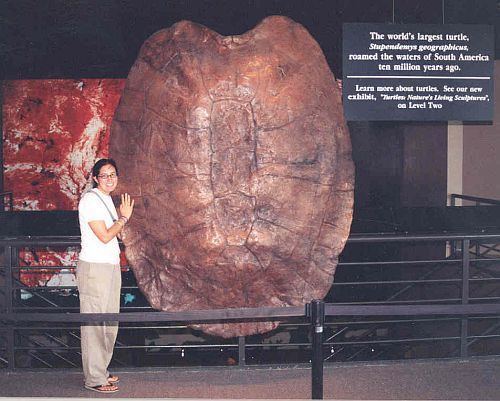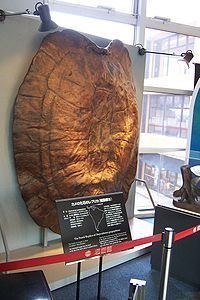Order Testudines | Phylum Chordata Rank Genus | |
 | ||
Similar Turtle, Reptile, Palaeotrionyx, Araripemys, Cerrejonemys | ||
Stupendemys is a prehistoric genus of freshwater turtle. Its fossils have been found in northern South America, in rocks dating from the late Miocene to the very start of the Pliocene, about 6 to 5 million years ago.

Stupendemys's carapace measured over 1.80 m (5.9 ft) in length and was also very wide. With an estimated total carapace length of more than 3.3 m (11 ft), it was the largest turtle that ever existed, surpassing even Archelon. The largest freshwater turtle living in the Neotropics today is the Arrau turtle (Podocnemis expansa), a pleurodire closely related to Stupendemys, but the Arrau turtle measures only 75 centimetres (30 in).

Two species have been described to date. Stupendemys geographicus was more robust; its remains have been found in the Urumaco Formation of Venezuela. Stupendemys souzai, marginally smaller and more slender, was recovered from the Solimões Formation in Acre State, Brazil.

Ecology
Its weight helped Stupendemys stay under water for extended periods of time, grazing on aquatic plants. On the other hand, it was probably a very weak swimmer, unable to move its bulk against a swift current, and thus probably avoided smaller streams.
Since S. souzai fossils have been found in sites which yield a rich fossil fauna, even though little is known with certainty, much can be inferred about the ecology of these animals. Among the aquatic animals that shared the habitat with S. souzai were fish, including catfish such as Phractocephalus and Callichthyidae, characids such as Acregoliath rancii and the tambaqui (Colossoma macropomum), the South American lungfish (Lepidosiren paradoxa), trahiras (e.g. Paleohoplias assisbrasiliensis) and freshwater rays and sharks. Crocodilians and other Crurotarsi were diverse and abundant, among them such taxa as Charactosuchus fisheri, Gryposuchus, Mourasuchus, Nettosuchidae and the giant Purussaurus brasiliensis. Other turtles and tortoises found in the same deposits are Chelus columbiana (a prehistoric relative of the mata mata) and Chelonoidis. Further aquatic vertebrates included river dolphins and the large darter "Anhinga" fraileyi.
Terrestrial mammals were plentiful, and the fauna included many megaherbivores, like the ground sloth Acremylodon campbelli, Toxodontidae (e.g. Gyrinodon and Trigodon), Proterotheriidae, and caviomorph rodents, some of them of immense size also (e.g. Kiyutherium, Neoepiblema, Phoberomys burmeisteri, Potamarchus murinus, Telicomys amazonensis and Tetrastylus). Smaller mammals living in that time and place were the ateline monkey Stirtonia and the bulldog bat Noctilio lacrimaelunaris.
Altogether, this fauna is massively dominated by large herbivores and generally lacks terrestrial carnivores. It can thus be assumed that the habitat was mostly low-lying rainforest that was seasonally flooded, as well as floodplains and swampland. The rivers must have been wide and slow-moving, as the fossil-rich rocks are alluvial deposits and do not show evidence of fast-flowing riverbeds that would have dug into the sediment deeply while depositing little of their own.
